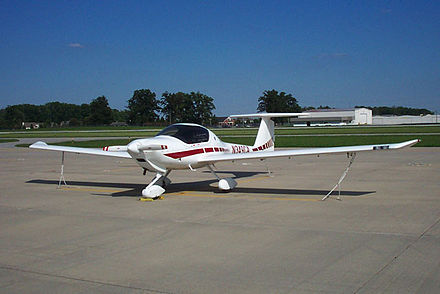Diamond Aircraft Industries is a Chinese-owned manufacturer of general aviation aircraft and motor gliders, based in Austria. It is the third largest manufacturer of aircraft for the general aviation sector, and had a global presence; possessing its own manufacturing facilities in Wiener Neustadt, Lower Austria and in London, Ontario, Canada, as well as further production lines operated as joint ventures in other nations, such as China.

The Rotax 912 is a naturally aspirated, air- and water-cooled, horizontally opposed four-cylinder, four-stroke, gear reduction-drive engine commonly used on certified aircraft, light sport aircraft, ultralight aircraft and unmanned aerial vehicles. Rotax produced its 50,000th 912-series engine in 2014.

The Liberty XL2 is a two-seat, low-wing, general aviation aircraft manufactured from 2004–2011 by Liberty Aerospace of Melbourne, Florida. A derivative of the Europa XS kit plane, it serves both as a touring aircraft for private flyers and as a flight trainer.

The Diamond DA40 Star is an Austrian four-seat, single-engine, light aircraft constructed from composite materials. Built in both Austria and Canada, it was developed as a four-seat version of the earlier DA20 by Diamond Aircraft Industries.
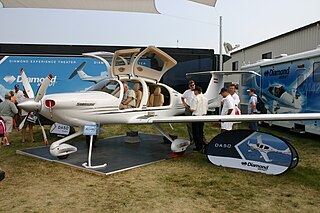
The Diamond DA50 Super Star and DA50 Magnum are Austrian five-place single-engine composite aircraft designed by Diamond Aircraft Industries. Introduced in 2006, the project was later put on hold until the turboprop JP7 variant was introduced in 2015.
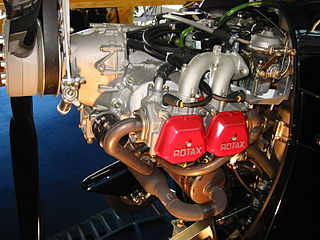
The Rotax 914 is a turbo-charged, four-stroke, four-cylinder, horizontally opposed aircraft engine with air-cooled cylinders and water-cooled cylinder heads. It is designed and built by the Austrian company BRP-Powertrain, owned by Bombardier Recreational Products (BRP), as part of its Rotax brand.
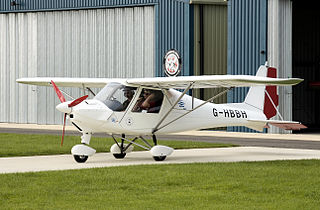
The Ikarus C42 is a two-seat, fixed tricycle gear, general aviation microlight aircraft, manufactured in Germany by Comco Ikarus. It is used primarily for flight training, touring and personal flying.

The Continental O-240 engine is a four-cylinder, horizontally opposed, air-cooled aircraft engine that was developed in the late 1960s for use in light aircraft by Continental Motors, Inc. The first O-240 was certified on 7 July 1971.

The Scheibe SF-25 Falke is a German touring motor glider developed from the earlier Bergfalke glider by Scheibe Flugzeugbau. Since May 2006 the business has been run by Scheibe Aircraft GmbH.

The Issoire APM 40 Simba is a four-seat light aircraft manufactured by the French manufacturer Issoire Aviation. It is entirely built from carbon-fiber-reinforced polymers. The aircraft's first flight was on 19 May 2009, and it made its public debut at the Paris Air Show in June 2009.

The Pipistrel Sinus is a single-engine ultralight, motor glider developed by Pipistrel.

The CFM Shadow is a British ultralight aircraft designed in the 1980s. It is of high wing, pusher, pod and boom layout and seats two. About 400 have been built.

The Coavio DF 2000 is a single-engine, high-wing all-metal ultralight aircraft with side-by-side seating for two. Built in Italy, production began in 2004.

The Aeroprakt A-20 Vista is a family of Ukrainian tandem two-seat high-wing, strut-braced, pusher configuration conventional landing gear, ultralight aircraft, produced by Aeroprakt. The A-20 was introduced into the North American market at AirVenture 1999.

The Roko Aero NG4 is a single-engined sport aircraft, available in both light-sport aircraft and ultralight models, which seats two side-by-side. It is in production in the Czech Republic.

The Diamond HK36 Super Dimona is an extensive family of Austrian low-wing, T-tailed, two-seat motor gliders that were designed by Wolf Hoffmann and currently produced by Diamond Aircraft Industries.
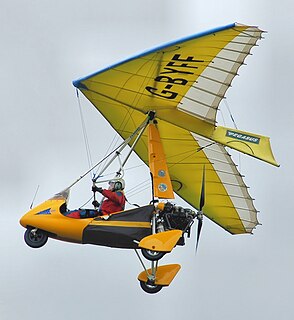
The Pegasus Quantum is a British two-seat, ultralight trike that was designed and produced by Pegasus Aviation and later by P&M Aviation. The aircraft was supplied as a completed aircraft.

The Bushcaddy R-120 is a Canadian kit aircraft produced by Canadian Light Aircraft Sales and Service (CLASS) of St. Lazare, Quebec and later Les Cedres, Quebec and now Bushcaddy of Lachute, Quebec and more recently Cornwall Regional Airport in Summerstown, Ontario.
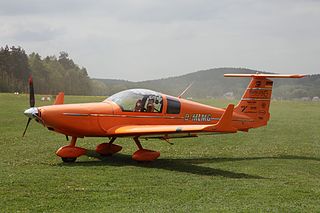
The Dova DV-1 Skylark is a Czech ultralight and light-sport aircraft produced by Dova Aircraft of Paskov. The aircraft is supplied as a kit for amateur construction or as a complete ready-to-fly-aircraft.
The Acrolite is a family of Canadian amateur-built aircraft, designed by Ron Wilson and produced by Acrolite Aircraft of Kakabeka Falls, Ontario, in the form of plans for amateur construction.


